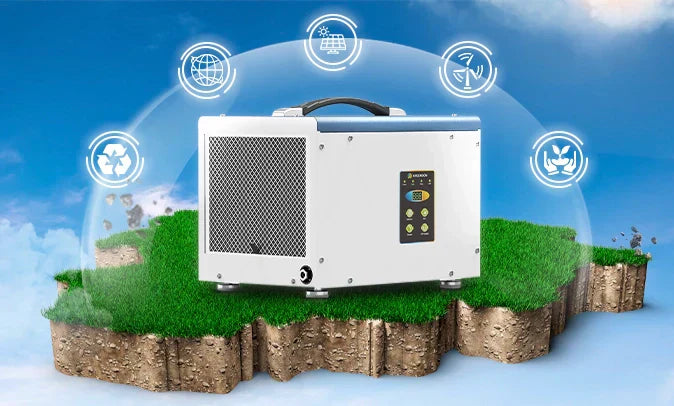
How Energy-Efficient Dehumidifiers Help Reduce Your Carbon Footprint
Jay BualWe feel the effects of global warming more and more each year, and with that comes the realization that we need to do our part in protecting the planet.
Even small actions can make a difference over time. One excellent example of this is choosing an energy-efficient room dehumidifier for your home.
Using certified energy-efficient dehumidifiers can significantly reduce greenhouse gas emissions and lower the overall carbon footprint of a household.
How do you know if a dehumidifier is truly efficient? An ENERGY STAR certification is a good indicator. This means that the product has undergone independent testing and passed high standards for performance and efficiency.
Let’s examine how energy-efficient dehumidifiers work and why choosing one is a smart move for you and the planet.
They consume less energy.

A dehumidifier that has earned an ENERGY STAR stamp can remove moisture from the air just as effectively as a non-ENERGY STAR dehumidifier (sometimes more so), except it operates at 14% less energy than non-certified counterparts on the market.
How significant is 14% in energy saved? A year’s worth of energy savings from a certified energy-efficient dehumidifier is enough to power a certified energy-efficient refrigerator for two months. If you can save that much electricity consumption each year, it would greatly reduce your household’s environmental footprint.
They have low Global Warming Potential (GWP).

As the industry became more aware about the significance of a substance’s global warming potential (GWP), many countries signed the Montreal Protocol, which enforced the phase-out and permanent ban of chemicals with exceptionally high GWP values (destructive HFCs and CFCs that deplete the ozone layer) to prevent further damage to our atmosphere. The United States doubled down on this matter further by enacting the American Innovation and Manufacturing (AIM) Act in December 2020, which directs the EPA to phase out HFCs and introduce more environment-friendly alternatives and technologies.
As such, newer models of dehumidifiers with ENERGY STAR certifications are almost guaranteed to use refrigerants with low GWP ratings.
At Argendon, we use R32 refrigerants for many of our dehumidifiers, such as the Shield, Guardian, and Sandidry series. R32 or difluoromethane is a hydrofluorocarbon (HFC) with a low GWP of 675. It is much lower, and therefore more environmentally friendly than the GWP of other refrigerants 1 that were once widely used:
|
Refrigerants |
Global Warming Potential (GWP) |
| R22 | 1,810 |
| R11 | 4,750 |
| R12 | 10,900 |
| R23 | 14,800 |
These GWP ratings signify the potential impact of greenhouse gases on the atmosphere. They signify how much energy (which translates as heat) a gas emits compared to carbon dioxide (CO2), whose GWP value is 1.2 The higher the GWP, the higher the carbon footprint. To reduce your carbon footprint, choose an ENERGY STAR commercial dehumidifier dehumidifier that uses R32.
They can extract more moisture in the air per unit of electricity consumed.

Many energy-efficient dehumidifiers today are LGR dehumidifiers. Argendon’s XStorm Series (XStorm Pro, XStorm Plus, and XStorm Max) are perfect examples.
Unlike conventional models, LGR dehumidifiers like the XStorm Series can extract moisture from the air below the standard 40-55 grains per pound (GPP). This means they can remove significantly more water vapor per kilowatt of electricity compared to non-LGR dehumidifiers.
With Argendon, you’ll have a dehumidifier that’s very good at lowering indoor humidity while using less electricity.
They are durable and long-lasting.

Energy-efficient dehumidifiers are built with sustainability in mind. They are manufactured with durable materials and designed to last for years of use, allowing you to maximize their energy savings and ROI potential. After all, it defeats the purpose of buying an energy-efficient dehumidifier if you must replace it with a new unit in one or two years.
Investing in a high-quality, energy-efficient dehumidifier is a sustainability practice. You won't have to constantly buy dehumidifying products like moisture-absorbing beads and plastic canisters, all of which will inevitably end up in landfills after you use them.
If you can take every opportunity to reduce the non-biodegradable or potentially harmful waste materials you release into the environment, that’s a meaningful effort in reducing your carbon footprint.
They prevent mold and remediation measures.

When treating a room or building with mold infestation, mold remediators often use chemicals like bleach and biocides to kill the fungi. These chemicals harm the environment, destroying marine and plant life if they penetrate the soil and natural waterways.
Bleach contains chlorine, which is highly toxic and can change the pH level of water, making it unsafe for fish, crustaceans, mollusks, and other aquatic life. When mixed with ammonia, which is very common in household cleaning products, it produces a foul-smelling gas that’s toxic to animals and humans.
Biocides, meanwhile, are used to exterminate a broad range of pests. Unfortunately, it can also destroy organisms that are beneficial to the ecosystem.
Mold prevention, therefore, is an important step in reducing your household’s carbon footprint and minimizing your environmental impact.
It’s remarkable how one decision, about something as prosaic as a household dehumidifier, can lay the groundwork for meaningful and lasting benefits for the environment.
You can always make the right choice. Check out Argendon's energy-efficient dehumidifiers on our Shop today.
